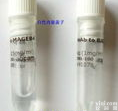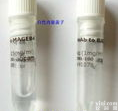本公司经销phospho-PLB/phospholamban(phospho Ser16+Thr17),磷酸化心脏磷蛋白抗体,克隆类型为polyclonal,宿主来源是Rabbit,phospho-PLB/phospholamban(phospho Ser16+Thr17)磷酸化心脏磷蛋白抗体可应用于WB、elisa、IP、IF、IHC等实验,欢迎垂询订购!
本公司经销phospho-PLB/phospholamban(phospho Ser16+Thr17),磷酸化心脏磷蛋白抗体,克隆类型为polyclonal,宿主来源是Rabbit,phospho-PLB/phospholamban(phospho Ser16+Thr17)磷酸化心脏磷蛋白抗体可应用于WB、elisa、IP、IF、IHC等实验,欢迎垂询订购!
货号:BY-6317R
英文名称:Anti-phospho-PLB/phospholamban(phospho Ser16+Thr17)
中文名称:磷酸化心脏磷蛋白抗体
其他名称:名Phospholamban (phospho S16+T17); p-Phospholamban (phospho S16+T17); Phospho-Phospholamban (Ser16/Thr17); phospholamban(phospho Ser16+Thr17); p-PLB(S16+T17); Cardiac phospholamban; CMD1P; PLB; PLN; PPLA_HUMAN.
抗体来源:Rabbit
克隆类型:polyclonal
蛋白分子量:predicted molecular weight: 25kDa
纯化方法:affinity purified by Protein A
交叉反应:hu, mo, rat, pig, cow
产品介绍:Defects in PLN are the cause of cardiomyopathy dilated type 1P (CMD1P) . Dilated cardiomyopathy is a disorder characterized by ventricular dilation and impaired systolic function, resulting in congestive heart failure and arrhythmia. Patients are at risk of premature death. Defects in PLN are the cause of cardiomyopathy familial hypertrophic type 18 (CMH18) . CMH18 is a hereditary heart disorder characterized by ventricular hypertrophy, which is usually asymmetric and often involves the interventricular septum. The symptoms include dyspnea, syncope, collapse, palpitations, and chest pain. They can be readily provoked by exercise. The disorder has inter- and intrafamilial variability ranging from benign to malignant forms with high risk of cardiac failure and sudden cardiac death.Function : Phospholamban has been postulated to regulate the activity of the calcium pump of cardiac sarcoplasmic reticulum.Subunit : Belongs to the phospholamban family.Subcellular Location : Mitochondrion membrane. Sarcoplasmic reticulum.Tissue Specificity : Heart.DISEASE : Defects in PLN are the cause of cardiomyopathy dilated type 1P (CMD1P) [MIM:609909]. Dilated cardiomyopathy is a disorder characterized by ventricular dilation and impaired systolic function, resulting in congestive heart failure and arrhythmia. Patients are at risk of premature death.Defects in PLN are the cause of cardiomyopathy familial hypertrophic type 18 (CMH18) [MIM:613874]. CMH18 is a hereditary heart disorder characterized by ventricular hypertrophy, which is usually asymmetric and often involves the interventricular septum. The symptoms include dyspnea, syncope, collapse, palpitations, and chest pain. They can be readily provoked by exercise. The disorder has inter- and intrafamilial variability ranging from benign to malignant forms with high risk of cardiac failure and sudden cardiac death.
 phospho-PLB/phospholamban(phospho Ser16+Thr17)磷酸化心脏磷蛋白抗体
phospho-PLB/phospholamban(phospho Ser16+Thr17)磷酸化心脏磷蛋白抗体
 phospho-PLB/phospholamban(phospho Ser16 Thr17),磷酸化心脏磷蛋白抗体
phospho-PLB/phospholamban(phospho Ser16 Thr17),磷酸化心脏磷蛋白抗体
 Anti-phospho-PLB/phospholamban(phospho Ser16+Thr17) 磷酸化心脏磷蛋白抗体
Anti-phospho-PLB/phospholamban(phospho Ser16+Thr17) 磷酸化心脏磷蛋白抗体
 Anti-phospho-PLB/phospholamban(phospho Ser16+Thr17) 磷酸化心脏磷蛋白抗体
Anti-phospho-PLB/phospholamban(phospho Ser16+Thr17) 磷酸化心脏磷蛋白抗体
 phospho-PLB/phospholamban(phospho Ser16+Thr17) 磷酸化心脏磷蛋白抗体
phospho-PLB/phospholamban(phospho Ser16+Thr17) 磷酸化心脏磷蛋白抗体
 phospho-PLB/phospholamban(phospho Ser16+Thr17) 磷酸化心脏磷蛋白抗体
phospho-PLB/phospholamban(phospho Ser16+Thr17) 磷酸化心脏磷蛋白抗体
 phospho-PLB/phospholamban(phospho Ser16+Thr17) 磷酸化心脏磷蛋白抗体
phospho-PLB/phospholamban(phospho Ser16+Thr17) 磷酸化心脏磷蛋白抗体
 phospho-PLB/phospholamban(phospho Ser16+Thr17) 磷酸化心脏磷蛋白抗体
phospho-PLB/phospholamban(phospho Ser16+Thr17) 磷酸化心脏磷蛋白抗体
 Anti-phospho-PLB/phospholamban(phospho Ser16+Thr17)磷酸化心脏磷蛋白抗体
Anti-phospho-PLB/phospholamban(phospho Ser16+Thr17)磷酸化心脏磷蛋白抗体
 phospho-PLB/phospholamban(phospho Ser16+Thr17) 磷酸化心脏磷蛋白抗体
phospho-PLB/phospholamban(phospho Ser16+Thr17) 磷酸化心脏磷蛋白抗体
 Phospho-HER3 (Tyr1289)碱性磷酸酶AP标记抗体,碱性磷酸酶AP标记磷酸化HER3受体抗体
Phospho-HER3 (Tyr1289)碱性磷酸酶AP标记抗体,碱性磷酸酶AP标记磷酸化HER3受体抗体
 Phospho-HER2 (Tyr686)碱性磷酸酶AP标记抗体,碱性磷酸酶AP标记磷酸化HER2受体抗体
Phospho-HER2 (Tyr686)碱性磷酸酶AP标记抗体,碱性磷酸酶AP标记磷酸化HER2受体抗体